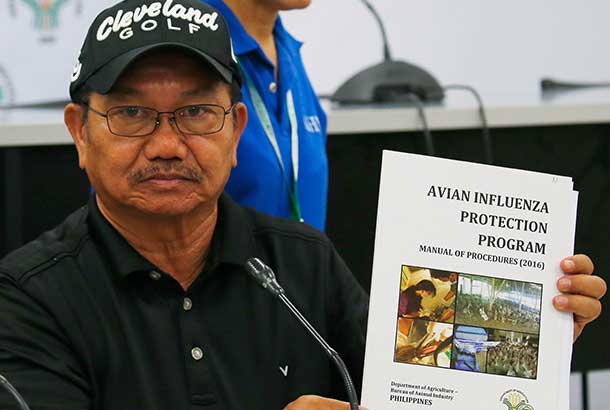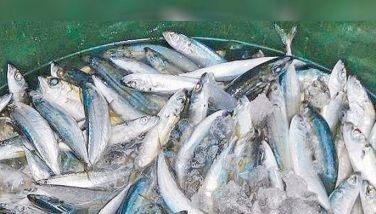Bird flu outbreak: Culling of over 200,000 birds to be finished today
August 14, 2017 | 12:44am

Department of Agriculture Secretary Emmanuel Piñol holds a manual for Avian Influenza Protection during a news conference on the confirmation of the first bird flu case in the country Friday, Aug. 11, 2017 in Manila, Philippines. Piñol said the Philippines will cull at least 400,000 birds after confirming its first bird flu outbreak, but that no animal-to-human transmission has been reported. AP Photo/Bullit Marquez
MANILA, Philippines — The Department of Agriculture targets to finish culling more than 200,000 poultry heads today as part of the government’s precautionary measure following the first ever bird flu outbreak in the country.
The DA is now in the process of culling an estimated 200,000 poultry heads—chicken, ducks, quails, pigeons and fighting roosters—within the town of San Luis in Pampanga to avoid the spread of the virus.
Pampanga has been placed in a state of calamity since Friday.
"At most, we want to finish the depopulation not later than tomorrow [Monday]. We will be trying to exhaust all our efforts and resources to finish these until tomorrow. We have to understand that we are not only talking about captive birds, we have to cull those stray birds as well," Agriculture Undersecretary Ariel Cayanan said in a phone interview Sunday.
Last Friday, the DA confirmed the outbreak of avian influenza virus (bird flu), the first case for the country, in San Luis, Pampanga which killed close to 40,000 poultry heads and placed the province in a state of calamity.
Initial field report as to how many heads have been culled already is still under validation.
Cayanan said Pampanga Gov. Lilia Pineda is shouldering the daily labor cost for the culling process.
"She said we can hire as many as we need to fast track depopulation. She will also shoulder all identified logistics all throughout the depopulation period," he added.
Test specimens confirmed the presence of highly pathogenic avian influenza (HPAI) subtype H5 in the town of San Agustin in San Luis, Pampanga, killing 37,000 birds covering six farms particularly poultry, quail and ducks.
According to Agriculture Secretary Emmanuel Piñol, quarantine officers will disinfect all the six farms after all birds in the area have been culled.
"After 21 days, sentinel birds will be deployed in the affected farms to serve as the basis in determining whether the virus is still present in the area. If the sentinel birds will not show signs of the disease, the quarantine restrictions will be lifted after 90 days," Piñol said.
Controlling the spread
The department maintained that culling the rest of the poultry population in the area is necessary to control the spread of disease in the shortest possible time as the remaining 200,000 may also be infected with bird flu.
The Bureau of Animal Industry has already declared a quarantine zone within a one-kilometer radius of the farms where the outbreak was confirmed.
Another seven-kilometer radius has been declared as a controlled zone where no fowls, eggs or other products could be brought out.
Apart from confining the area, the department has ordered the ban on the shipment of fowls from Luzon to the other parts of the country.
"However, the transshipment through the Manila International Airport of chicks, hatching eggs and other fowls from other countries coming into Luzon or other parts of the country will be allowed with the advisory that stringent quarantine protocols must be observed," Piñol said.
This means that chicken brought in from the United States intended for shipment to the Visayas or Mindanao may not be taken out of the boxes and must be loaded directly into the connecting flights.
Low chance of virus transmission to humans
On the other hand, the Department of Environment and Natural Resources-Biodiversity Management Bureau warned the public on approaching migratory birds in light of fears that the current bird flu outbreak is caused by the birds.
"We discourage the killing or poaching of the birds because this could just worsen the situation. Close contact with the birds will risk transmission," DENR-BMB Director Mundita Lim said.
"We may need to determine the actual strain and do some epidemiological assessments so we can make the proper disease management recommendations, along with the DA and the DOH, in accordance with the creation of an inter-agency committee on zoonosis," she added.
Zoonosis is a disease that can be transmitted to humans from animals.
There has been no report yet of poultry to human contamination and the DOH assured that virus transmission from animals to humans is low.
BAI is now in the process of sending the samples to the Australian Animal Health Laboratory, a World Organization for Animal Health (OIE) Reference Laboratory for avian influenza for further testing.
The DENR explained that the annual bird migration season in the Philippines is expected to start around September (southward migration) and return to their breeding grounds by March in the following year (northward migration).
This means that birds stop briefly along wetlands—swamps, marshes, intertidal and coastal areas, rivers, ponds, lakes, as well as forests throughout the country, to rest and refuel for their onward journey.
The DENR will also issue a memorandum to all its regional directors to intensify surveillance at airports and seaports pertaining to the smuggling of wild birds.
BrandSpace Articles
<
>
Philstar
x
- Latest
- Trending
Trending
Latest
Trending
Latest
Recommended




























